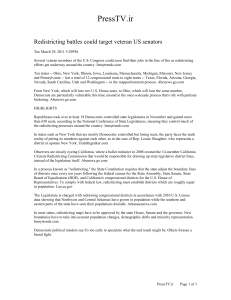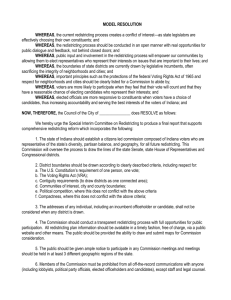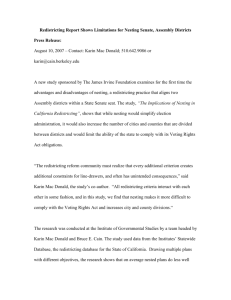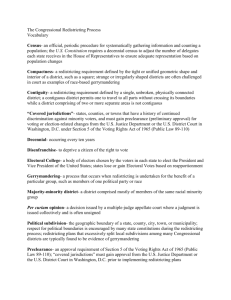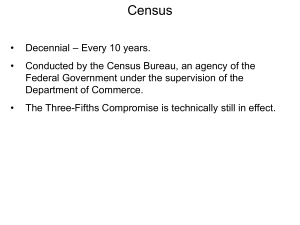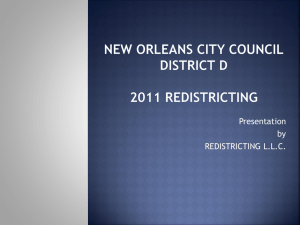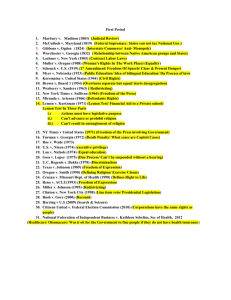Redistricting 101 - About Redistricting
advertisement
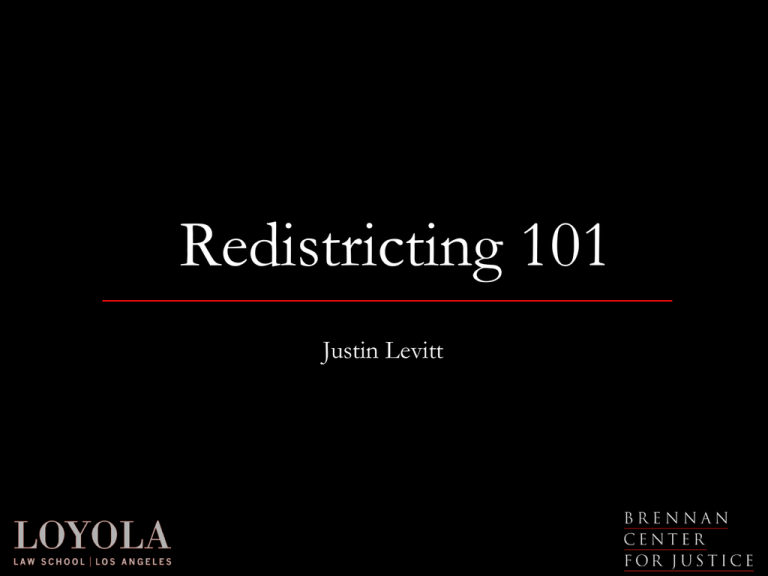
Redistricting 101 Justin Levitt Today’s conversation • What? • When? • Who? • Where? • Why? • How? Today’s conversation • What? • When? • Who? • Where? • Why? • How? What is “redistricting”? Draw (and re-draw) lines that determine which voters are represented by each legislative seat • Federal • State • Local A brief history • Districts were often made of towns or counties, or groups of towns or counties A brief history • Districts were often made of towns or counties, or groups of towns or counties A little more history • Districts were often made of towns or counties, or groups of towns or counties 1 state Senator 10 people 1 state Senator 10 people 1 state Senator 10 people A little more history • But the population did not grow equally 1 state Senator 1,000 people 1 state Senator 10,000 people 1 state Senator 100 people Constitutional mandate to redraw lines Baker v. Carr, 1962 Districts have to have roughly equal population And so… 2000 ― Census Day 2001 ― Redistricting 2010 ― Census Day 2011 ― Redistricting 2020 ― Census Day 2021 ― Redistricting Today’s conversation • What? • When? • Who? • Where? • Why? • How? Key redistricting dates April 1, 2010 ― Census Day January 10, 2011 ― Apportionment to U.S. House April 1, 2011 ― Redistricting data to states End of session 2011 ― Most redistricting complete or early 2012 Today’s conversation • What? • When? • Who? • Where? • Why? • How? Who draws the lines In most states, the legislature has primary control • State legislative districts: 37 states • Congressional districts: 37 states (and 7 states with 1 Congressional district) Other redistricting institutions State legislative districts Congressional districts * * Primary control in the legislature Advisory Backup Primary control outside legislature Elected officials Examples of advisory/backup bodies Maine Oregon Texas Illinois 2/3 Examples of commissions Colorado Missouri 70% Montana California 9 votes … and if the process breaks down 2000 cycle judicial action Someone filed suit … and if that should fail 2000 cycle judicial action State leg. Congress* Courts asked to step in 33 21 Court drew lines itself 11 9 * 7 states had only one congressional district in the 2000 cycle Today’s conversation • What? • When? • Who? • Where? • Why? • How? “Where” starts with federal protections • Equal population • Race/ethnicity and the Voting Rights Act Equal population Baker v. Carr, 1962 • Congress: as equal as possible • State legislature: up to 10% “deviation,” if for good reason “Where” starts with federal protections • Equal population • Race/ethnicity and the Voting Rights Act Minority representation Cracking Packing The Voting Rights Act Section 2 • Are half of the potential voters in a concentrated area minorities? • Would they generally vote together? • Would the rest of the voters in the area generally choose different candidates? “Totality of the circumstances” • • • • • • rough overall proportionality in the jurisdiction history of voting-related discrimination extent of racially polarized voting extent of discriminatory voting practices or procedures exclusion of minority members from candidate slating extent to which minority group members bear the effects of past discrimination in areas such as education, employment, and health, which hinder their ability to participate effectively in the political process • extent to which minority members have been elected • extent to which elected officials are unresponsive to the particularized needs of members of the minority group Complying with the Voting Rights Act • Are half of the potential voters in a concentrated area minorities? • Would they generally vote together? • Would the rest of the voters in the area generally choose different candidates? • Are the minority voters otherwise protected, in the totality of the circumstances? Do Not Dilute • Draw an “opportunity district” • Equal opportunity to elect representatives of choice Adjacent populations and the VRA Chicago suburbs Latino/Hispanic African-American Adjacent populations and the VRA The Latino population is large and compact – but drawing a compact Latino opportunity district cuts through the African-American community Chicago suburbs Latino/Hispanic African-American Adjacent populations and the VRA The African-American population is also large and compact – but drawing a compact opportunity district cuts through the Latino community Chicago suburbs Latino/Hispanic African-American Adjacent populations and the VRA Creativity reveals a solution for both communities Chicago suburbs Latino/Hispanic African-American The Voting Rights Act Section 5 • “Preclearance” for certain jurisdictions • Is the new map intended to dilute minority votes? • Does the new map leave minority voters worse off? Section 5 objections • Most review goes through DOJ • Data reviewed to see if minorities are worse off • But there are many thousands of submissions See something? Say something! Race and ethnicity beyond the VRA • Voting Rights Act protects certain voters • With other groups of minorities, it is OK to consider race and ethnicity, among other factors • Race and ethnicity just can’t “predominate” without a really good reason After federal law, add state limitations State leg. Congress • Contiguity 49 23 • Political boundaries 41 18 • Compactness 36 17 • Communities of interest 22 13 • Partisanship/competition 12 10 • Nesting 14 n/a After federal law, add state limitations State leg. Congress • Contiguity 49 23 • Political boundaries 41 18 • Compactness 36 17 • Communities of interest 22 13 • Partisanship/competition 12 10 • Nesting 14 n/a Contiguity • All parts of the district are adjacent to each other Not contiguous Contiguous After federal law, add state limitations State leg. Congress • Contiguity 49 23 • Political boundaries 41 18 • Compactness 36 17 • Communities of interest 22 13 • Partisanship/competition 12 10 • Nesting 14 n/a Political boundaries • Follow county / city / town / ward lines • Note: may split populations in unexpected ways After federal law, add state limitations State leg. Congress • Contiguity 49 23 • Political boundaries 41 18 • Compactness 36 17 • Communities of interest 22 13 • Partisanship/competition 12 10 • Nesting 14 n/a Compactness • Usually concerns the appearance of the district (or how close people live to each other) Less compact More compact After federal law, add state limitations State leg. Congress • Contiguity 49 23 • Political boundaries 41 18 • Compactness 36 17 • Communities of interest 22 13 • Partisanship/competition 12 10 • Nesting 14 n/a Communities of interest • Definitions vary, but revolve around similar elements • Kansas: “Social, cultural, racial, ethnic, and economic interests common to the population of the area, which are probable subjects of legislation . . . should be considered. [S]ome communities of interest lend themselves more readily than others to being embodied in legislative districts. . .” Can and should be different in different parts of the state Communities of interest • • • • • • • • • Social interests Cultural interests Racial / ethnic interests Economic / trade interests Geographic interests Communication and transportation networks Media markets Urban and rural interests Occupations and lifestyles After federal law, add state limitations State leg. Congress • Contiguity 49 23 • Political boundaries 41 18 • Compactness 36 17 • Communities of interest 22 13 • Partisanship/competition 12 10 • Nesting 14 n/a Partisanship and competition • Of these states, most prohibit undue partisan favoritism or targeting particular individuals • Some affirmatively encourage competition After federal law, add state limitations State leg. Congress • Contiguity 49 23 • Political boundaries 41 18 • Compactness 36 17 • Communities of interest 22 13 • Partisanship/competition 12 10 • Nesting 14 n/a Nesting Senate Assembly Not nested Nested A quick review State legislature Congress • Who? Legislature or commission (+ courts) • Where? Equal population Voting Rights Act Contiguity Political boundaries Compactness Communities of interest Partisanship Nesting Equal population Voting Rights Act Today’s conversation • What? • When? • Who? • Where? • Why? • How? Why does redistricting matter? If you care about representation, and you care about political power, then you care about redistricting This isn’t about districts that look pretty Is this a good district? Is this a good district? You can’t know if a district is “good,” unless you know what it’s trying to achieve Is she a good singer? And pretty shapes are not neutral Source: Michael McDonald, Midwest Mapping Project So why does redistricting matter? • Politicians choosing their voters • Eliminating incumbents or challengers Conflating public, partisan, personal interests • Barack Obama: strong challenge for Congress in 2000 Barack Obama’s house 2002 district Conflating public, partisan, personal interests • Lorraine Koppell: strong challenge for state Senate in 2000 2002 district Lorraine Koppell’s house Conflating public, partisan, personal interests • Hakeem Jeffries: strong challenge for state Assembly in 2000 Hakeem Jeffries’s house 2002 district Why does redistricting matter? • Politicians choosing their voters • Eliminating incumbents or challengers • Diluting minority votes • Splitting up communities Today’s conversation • What? • When? • Who? • Where? • Why? • How? Principles for redistricting in the public interest 1. Meaningful transparency 2. Meaningful independence 3. Meaningful diversity 4. Meaningful guidance Redistricting in the public interest 1. Meaningful transparency 2. Meaningful independence 3. Meaningful diversity 4. Meaningful guidance Meaningful transparency • Multiple opportunities for meaningful public input - Before drafts - After drafts • Data and tools to facilitate response • Some explanation from redistricting body Redistricting in the public interest 1. Meaningful transparency 2. Meaningful independence 3. Meaningful diversity 4. Meaningful guidance Meaningful independence • One of the players shouldn’t also be the umpire • This is not the same as taking politics out of redistricting • Legislature can still have a role - Select those who draw the lines - Review lines afterward Redistricting in the public interest 1. Meaningful transparency 2. Meaningful independence 3. Meaningful diversity 4. Meaningful guidance Meaningful diversity • Those who draw the lines should reflect the state • Need redistricting body of sufficient size • Need rules/incentives to choose diverse membership Redistricting in the public interest 1. Meaningful transparency 2. Meaningful independence 3. Meaningful diversity 4. Meaningful guidance Meaningful guidance • Criteria that reflect basic goals • Enough flexibility to accommodate local exceptions • Focus on communities of interest as building blocks • Legislative majority should reflect consistent statewide majority Influencing redistricting (short-term) • Educate your community • Inform the media • Identify and map community boundaries • Attend hearings • Present alternative maps Ways to influence the maps Testimony at hearing: Where are the boundaries of the community I serve? Official map Press Nonprofits Justice Courts Input about communities can be simple Training others • What? • When? • Why? • Who? • Where? • How? What is the process in your state? Where are the points of access? Start now and start diverse Ventura County task force • Ventura County: farmworkers and the Reagan Library • Redistricting Task Force “to increase political representation, voter participation, and civic engagement of historically underrepresented communities of color and low-income working families in the Ventura County region through a program of community organizing, research, and grassroots advocacy around the 2001 redistricting process.” Start now and start diverse Ventura County citizens’ commission • Involvement from diverse groups LWV, NAACP, LULAC, labor, faith-based groups • Focus on local redistricting, focus on communities • Early outreach to county supervisors • Task force map was essentially adopted as final plan Influencing redistricting (long-term) • Alternative rules - e.g., how incarcerated populations are counted • Alternative procedures - e.g., greater transparency • Alternative redistricting entities - e.g., more independent bodies • Alternative voting systems - e.g., choice voting Further information Justin Levitt Loyola Law School justin.levitt@lls.edu Brennan Center for Justice Citizen’s Guide to Redistricting www.brennancenter.org

